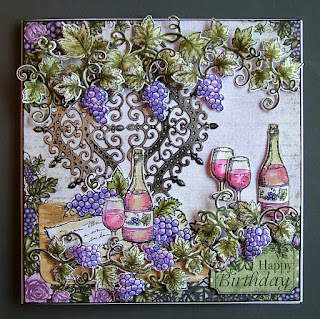I have had so much fun playing
with the new Bangle
Weaver Tool designed by Kleshna for Beadalon. I simply love it and my mind is bursting
with ideas. It can be used to create so many different styles of bangle, from
structured wire weaves to Boho and ethnic styles using fabric strips. Why not
try recycling old T shirts, bedding or carrier bags.
Beads Direct asked me to create a few designs for their blog – they took some
lovely pics too. Do check the Beads Direct Blog for lots of great projects from
the Design Team.
The instructions included are
very easy to follow, and it can be used to weave so many different types of
materials, for example:
The possibilities are simply
endless.
I find that Kumihimo
bobbins are invaluable for keeping cords or ribbons manageable, or Spool
Tamers if you are weaving beading
wires. Bead
stoppers are also handy for temporarily holding beaded cables or ribbons in
place. You will also need blunt ended needles with a large eye to replace the
warp. The bodkin
set recommended by Kleshna is very good. However, when warping ribbon or
fabric strip weaves I found that an extra-long bodkin (e.g. elastic threader
available from haberdashery stores) was much easier to use. Note: The warp pegs
are quite sharp so I would not recommend the tool for young children, and do
protect you table top from scratches by using with a mat.
Woven Bangle Designs
I have created a few designs for
you using Recycled
Sari Silk Ribbons and 0.6mm
Supplemax Monofilament along with various beads from my stash. I hope that
they inspire you to get started with your own designs. I followed the basic
instructions included with the tool for setting up, weaving and warping. I just love this fabulous tool.
Happy beading, Anne x.
Materials used:
·
Turquoise Toho Seed Beads Size 8 (8TR55)
·
Silver Plated Crimp Beads #2 (F317)
Floral Trellis Bangle
I used 0.6mm Supplemax, the vintage
pink bead mix and a few flowers to create this bangle. I love the way that the
beads appear to be suspended on the transparent woven trellis.
Unwind and cut off approximately
4m from the spool and thread with 231 beads from the pink mix. Wind onto a
Kumihimo bobbin. I used a Bead Stopper to clamp the monofilament while weaving
(you could crimp them together at this stage).
Weave 7 rows with one plain and
one beaded strand, moving up 3 beads to the front per ‘wrap’ with the beaded
strand. The weave holds the beads in place.
Unwind approximately 1.5m off from
the plain spool before cutting. Pass one of the strands down through the warp
to the other side to give the 2 warping strands. Warp the bangle according to the included instructions
and secure using crimp beads. I adjusted the tension by pulling in the warp
threads to give a bangle width of approx. 1.5 inches as I worked around.
Next stitch on flowers using the
thinner 0.25mm Supplemax. Tie on the thread, pass up through the flower, add on
a small lemon seed bead, pass back down the flower and tie/knot back onto the
trellis. Weave the thread through the trellis between the flowers.
Spring Garden Bangle
I used strips of the silk ribbon
in yellows/creams and greens for the weave and 0.6mm Supplemax for the warp,
then embellished with beads.
Join the silk ribbon strips by
stitching them together (just a couple of small stitches to anchor) using
beading thread. Prepare approximately 1.5 to 2m each of yellows/creams and
greens. Twist the strips and wind onto Kumihimo bobbins for weaving. Twisting the strips gives added strength and
structure to the weave. After weaving 7 rows secure the silk strips with a few
stitches.
Use approximately 2m of the 0.6mm
Supplemax to warp, adjusting the bangle width to approx. 1.5 inches by gently pulling
on both the warps as you work around. I generally prefer to tighten and adjust
the warp as I work on silk weaves, rather than after the warp pegs have been
removed.
Use crimps to secure the ends. Once
removed from the warp pegs neaten the cut ends of the silk by stitching them
down, hiding them on the inside of the bangle.
I found the use of an extra long
bodkin really useful for pulling the warp strands though the channels of the
ribbon weave. Tip: Push the eye of the bodkin through the channel, thread with
the monofilament, and then pull through. Unthread and repeat pulling the cables
through from each side.
Then use 0.6mm Supplemax to add
small green beads (from the Glam Green Vintage Mix) along the top and bottom
edges. Simply weave the cable through, following the pattern of the silk weave,
adding 11 groups of 3 beads on each edge (i.e. you will need 66 beads in
total). Secure with crimps, hiding them by burying into the silk weave.
Further embellish the bangle by
stitching on groups of green beads, along with purple and white flowers, using
co-ordinating beading thread. Use peridot seed beads to attach the green beads
and flowers, and to create little beaded leaves. The leaves are made by threading
9 beads, passing back down the eighth bead, adding 6 beads and finally passing back
through the first bead. Ensure that groups of beads are anchored well by
stitching into the silk. Stitch through the back of the bangle when moving
between beaded sections.
Blue Lagoon Bangle
This bangle was woven in the same
way as the Spring Garden Bangle. A random mix of blue and green silk ribbons
were used but they were not twisted before weaving. I tightened up the warp
tension after removing the warp pegs (as described in the instruction booklet).
The resultant weave is softer and less structured than when using twisted
strips. It is also more difficult to get an even tension. However, I was very
pleased with the results, giving the design a more organic feel.
To embellish, first attach groups
of 2 or 3 beads onto headpins. Anchor these onto the warp (buried in the silk
weave) for stability, attaching them with wrapped loops. Further embellish by
stitching on clusters of beads from the Glam Green Vintage mix, plus green and
turquoise flowers, along with turquoise and peridot seed beads.
Tooty Fruity Bangle
In this design I added beads
(from the Pink Vintage Mix) onto the warp to create a border along the edges of
the bangle. I also included a cross grain ribbon in the weave to give added
texture.
Prepare approximately 1.5 to 2m
each of bright pink and dark purple silk strips, twist and wind them onto
Kumihimo bobbins. The bangle is woven in the same way as the Spring Garden
Bangle but weaving with one pink strand, and combining a pink cross grain
ribbon along with the purple strand.
Warp using approximately 3m of
0.6mm Supplemax and add a bead onto each warp strand before passing them back
down the channel. Note: when adding beads to the outer warp edges they need to
be fairly large when using silk weave. Smaller beads just disappear down into
the channels.
Finally embellish by stitching
sets of 3 beads in rows around the weave. You will need a total of 66 beads (11
groups of 3 per row).
Indian Rose Bangle
I chose 6 different silk ribbon
colours to weave this one. They were woven in the same way as the Spring Garden
bangle but the colour combination was changed every 3 rows: green and purple
for the first 3 rows, yellow and pink for the next 3 rows, cream and cerise for
the top 3 rows. The bangle was warped using approximately 2m of the 0.6mm
Supplemax.
Use the silk ribbons to create a
flower and embellish using beads from the Pink Vintage Mix:
Create 5 small cerise petals from
1.5 inch squares. First fold the square in half, then fold the outer edges to
the centre and down to create a small folded triangle with raw edges along the
base. Use small running stitches along the base to gather the petal.
Create 5 large turquoise petals using
4 X 1.5 inch strips. First fold the strips in half and round off the corners on
the raw edges. Use small running stitches along the raw edges and pull up to
gather the petal.
Arrange the petals and stitch
them onto the bangle. Add beads to cover the centre and raw edges.
Encrusted Treasure Bangle
This bangle was woven using
knotted silk strands along with a strand of beaded 0.6mm Supplemax (Classic
White Mix). I just love the textures on this one.
Prepare approximately 1.5 to 2m each of turquoise/teal and
mixed red strips, stitching lengths together with a few stitches to hold, and
then knot over the join. Next knot the silk strips at intervals of
approximately 2 inches right along the length. Don’t pull too hard or the silk
will tear. Loosely twist the teal and red strands together and wind onto a
Kumihimo bobbin.
Keeping the 0.6mm Supplemax on
the reel, thread a length of approximately 1m with a random mix of the white
beads. Weave the bangle in a similar way as the Floral Trellis, pushing up 3-5
beads to the front per ‘wrap’ with the beaded strand. The weave holds the beads
in place.
Warp using approximately 3m of
0.6mm Supplemax and secure with crimps.



































